Causes of damage to overhead power lines
The reasons for the failure of overhead power lines are mainly due to the following factors: overvoltages (atmospheric and switching), changes in ambient temperature, wind action, ice formation on wires, vibrations, “dances” of wires, air pollution.
Here is a brief description of some of the factors listed.
Atmospheric power surges on power lines are due to thunderstorms. Such short-term overvoltages often result in breakdowns of the insulation gaps, and in particular insulation overlap, and sometimes its breakdown or failure.
Overlapping insulation is usually accompanied by electric arc, which is maintained even after overvoltage, i.e. at operating voltage. An arc means a short circuit, so the fault should be automatically tripped.
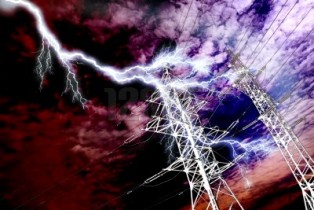
Lightning struck in an overhead line
Switching (internal) surges occur when on and off switches… Their effect on the insulation of network devices is similar to the effect of atmospheric surges. Overlap should also be turned off automatically.
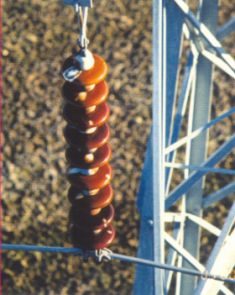 Destruction of the insulation skirt by an arc
Destruction of the insulation skirt by an arc
In networks up to 220 kV atmospheric overvoltages are usually more dangerous. In networks of 330 kV and above, switching surges are more dangerous.
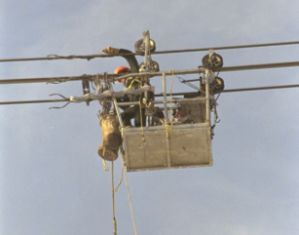
Repair of overhead wires
Changes in air temperature are quite large, the range can be from -40 to +40 ° C, in addition, the conductor of the overhead line is heated by current, and with economically possible power, the temperature of the conductor is 2-5 ° higher than that of air.
Lowering the air temperature increases the allowable heating temperature and conductor current. At the same time, with a decrease in temperature, the length of the wire decreases, which, at fixed attachment points, increases mechanical stresses.
An increase in the temperature of the wires leads to their annealing and a decrease in mechanical strength. Also, as the temperature rises, the wires lengthen and the sag arrows increase. As a result, overhead line sizes and insulation distances, i.e. the reliability and safety of the overhead power line is reduced.
Wind action leads to the appearance of an additional horizontal force, therefore, to an additional mechanical load on the wires, cables and supports. At the same time, the voltages of the wires and cables and the mechanical stresses of their material increase. Additional bending forces also appear on the supports. In case of high winds, there may be cases of simultaneous breaking of a number of line supports.
Ice formations on the wires as a result of rain and fog, as well as snow, frost and other supercooled particles. Ice formations lead to the appearance of a significant mechanical load on wires, cables and supports in the form of additional vertical forces. This reduces the safety margins for wires, cables and line supports.
In separate sections, the sagging arrows of the wires change, the wires are brought together, the insulation distances are reduced. As a result of ice formations, interruptions of conductors and destruction of supports, convergence and collision of conductors with overlapping insulation gaps occur not only during surges, but also at normal operating voltage.
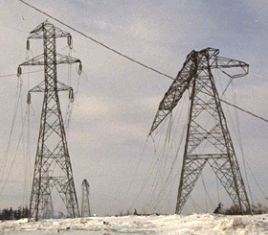
Overhead supports destroyed due to ice
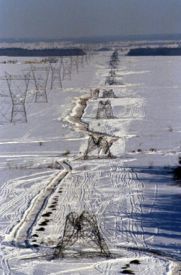
Cascading destruction of power line supports in icy conditions
Vibration - these are vibrations of wires with a high frequency (5-50 Hz), short wavelength (2-10 m) and insignificant amplitude (2-3 diameters of the wire). These vibrations occur almost constantly and are caused by weak winds that cause turbulence in the flow around the surface of the air conductor. Due to vibration, «fatigue» of the wire material occurs and breaks occur in individual wires near the places where the wire is attached near the clamps, near the supports. This leads to a weakening of the cross-section of the wires, and sometimes to their breakage.
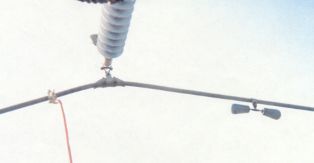
Vibration damper on the wire
"Dance" of wires — these are their oscillations with a low frequency (0.2-0.4 Hz), a long wavelength (of the order of one or two ranges) and a significant amplitude (0.5-5 m and more) .The duration of these fluctuations is usually short, but sometimes reaches several days.
Wire dance is usually observed in relatively strong wind and ice, more often in large cross-section wires. When wires dance, large mechanical forces occur that act on wires and supports, often causing wires to break and sometimes supports to break. When the conductors dance, the insulation distances are reduced due to the large amplitude of oscillations, in some cases the conductors collide, due to which overlaps are possible at the operating voltage of the line. Wire dancing is relatively rare, but it leads to the worst accidents on overhead power lines.
Read more about it here. "Vibration and Dancing of Wires on Overhead Power Lines".
Air pollution caused by the presence of ash particles, cement dust, chemical compounds (salts), etc. is dangerous for the operation of overhead power lines. The deposition of these particles on the wet surface of the insulation of the line and electrical equipment leads to the appearance of conductive channels andweakens the insulation with the possibility of overlapping it not only during surges, but also under normal operating voltage. Pollution due to the high presence of salts in the air along the sea coast can lead to active oxidation of aluminum and deterioration of the mechanical strength of the wires.
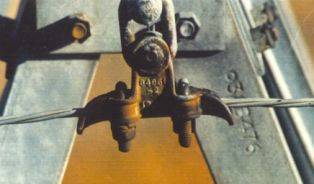
Corroded support bracket
The decay of their wood affects the damage of overhead power lines with wooden supports.
The reliability of overhead lines is also affected by some other operating conditions, for example soil properties, which is particularly important for overhead lines in the Far North.
